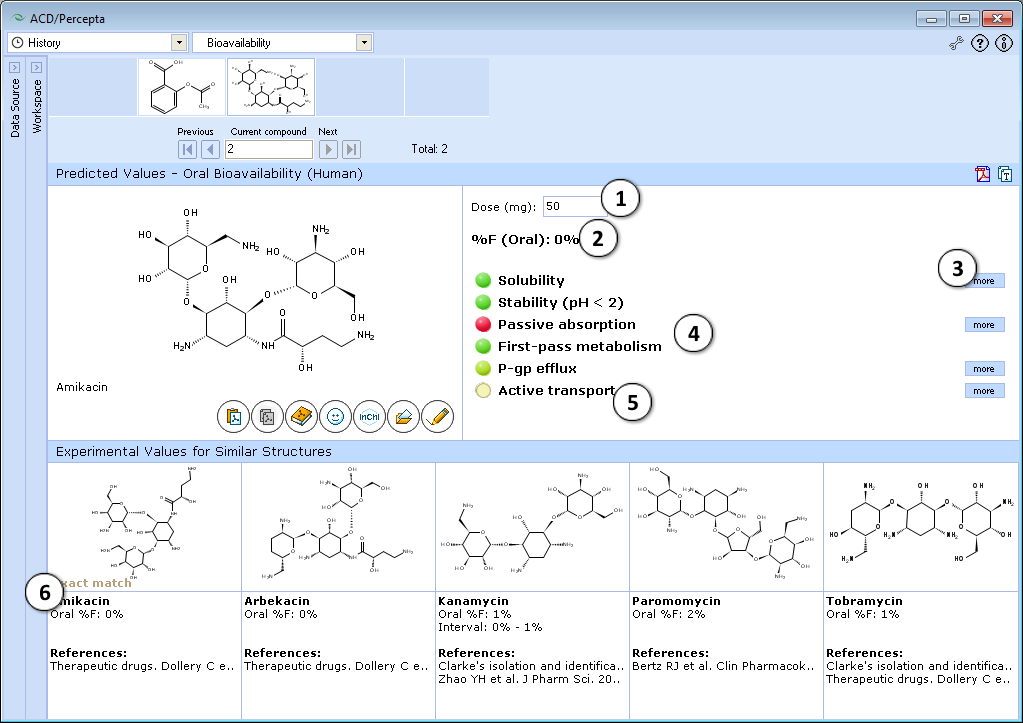Oral Bioavailability
Overview
Oral Bioavailability module predicts the fraction of the specified drug dose that reaches systemic circulation after oral administration (%F). For calculation of quantitative %F values, Oral bioavailability module uses the same kind of absorption simulation that is implemented in ACD/PK Explorer.
Features
- Predicts %F after oral administration with the possibility to explore dose-dependence of bioavailability
- Predicts a number of endpoints that affect oral bioavailability:
- Solubility (dose/solubility ratio)
- Stability in acidic media
- Intestinal membrane permeability by passive or active transport
- Likelihood of P-gp efflux
- Likelihood of first pass metabolism in the liver
- Visualizes the contributions of underlying properties with traffic-lights (green = good, red = problematic) for easy interpretation
- Displays experimental %F values for up to 5 similar structures from Bioavailability DB along with literature references.
Interface

- 50 mg is the default oral drug dose used in calculations. Enter any desired value to explore the effect of dose on oral bioavailability.

- a. Click the "Undo" button to reset the specified drug dose and to recalculate %F using the default settings.
- b. Click to recalculate %F using the currently specified dose.
- Predicted %F (Oral) value.

- Click to see more details regarding the calculation of the particular property.
- Factors affecting oral bioavailability (see below for details).
- Hover over a title to view a screentip with a short description.
- Up to 5 similar structures in the Bioavailability DB with experimental values and references.
Traffic-lights system explanation
- Solubility in gastrointestinal tract:
- Green – good – dose/solubility ratio < 1.
- Yellow – moderate – dose/solubility ratio between 1 and 10.
- Red – poor – dose/solubility ratio > 10.
- Stability – susceptibility to acid hydrolysis in stomach:
- Red – only assigned to highly reactive compounds that decompose in stomach very quickly. Red light means that F (oral) <10%, overriding any probabilistic prediction (i.e., do not pay attention to predicted probabilities in this particular case).
- Passive absorption – ability to cross human intestinal membrane by passive diffusion:
- Red – intestinal passive absorption <30%. %F (oral) is always less than passive absorption.
- Green – good (>70%) passive absorption across intestinal barrier. Passive absorption does not effect %F.
- First-pass metabolism – susceptibility to metabolic transformations catalyzed by enzymes in liver and intestine:
- Red – high probability that first-pass metabolism is >50%. In this case %F (oral) is likely to be dose dependent and not to exceed 40%.
- Green – compound probably does not undergo significant first-pass metabolism.
- P-gp efflux – susceptibility to backward transport through intestinal membrane:
- Red – compound is P-glycoprotein substrate. This effect is mostly important when compound is metabolized by CYP3A4
- Active transport – susceptibility to active transport through intestinal membrane:
- Green – compound is actively transported by PepT1, ASBT or other enzymes.
- Red light never appears, as this factor can only increase %F (oral).
Technical information
Training set size: 788
Internal validation set size: N/A*
* - Since the formal basis for the probabilistic prediction still are "mechanistic" considerations, there was no particular emphasis on external model validation - similarly to the knowledge based "expert-like". As result, the statistical results obtained for the training set compounds are the only available quantitative characteristics for the ACD/Oral Bioavailability model.
Main sources of experimental data:
- Reference books:
- Therapeutic Drugs, Dolery, C., Ed. 2nd Edition, Churchill Livingstone, New York, NY, 1999
- Clarke's Isolation and Identification of Drugs, Moffat, A.C., Jackson, J.V., Moss, M.S., Widdop, B., Eds. 2nd Edition, The Pharmaceutical Press, London, 1986
- Various articles from peer-reviewed scientific journals*
* - Both articles reporting oral bioavailability models by other authors (i.e. with larger collections of experimental data per article) and dealing with detailed experimental pharmacokinetic characterization (i.e. usually only several compounds per article) were available for the training set construction.
Training set statistics
| Subset | Observed | Calculated probability (p) | |||
|---|---|---|---|---|---|
| >0.5 | <0.5 | ||||
| Entire training set N = 788* |
True | 415 (52.7%) |
114 (14.5%) | ||
| False | 81 (10.3%) |
178 (22.6%) | |||
| Accuracy |
| ||||
| Sensitivity |
| ||||
| Specificity |
| ||||
* - Since ACD/Bioavailability model does not utilize GALAS modeling methodology, no additional parameters (i.e., RI) are available to enable additional filtering of more reliable predictions.
| Subset | Observed | Calculated probability (p) | |||
|---|---|---|---|---|---|
| >0.5 | <0.5 | ||||
| Entire training set N = 788* |
True | 172 (21.8%) |
126 (16.0%) | ||
| False | 44 (5.6%) |
446 (56.6%) | |||
| Accuracy |
| ||||
| Sensitivity |
| ||||
| Specificity |
| ||||
* - Since ACD/Bioavailability model does not utilize GALAS modeling methodology, no additional parameters (i.e., RI) are available to enable additional filtering of more reliable predictions.